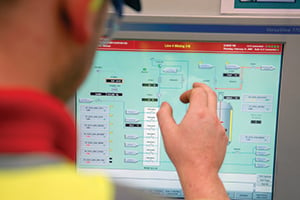Selecting the right solution when designing your batch-sequencing system saves valuable design time and validation effort and simplifies maintenance
 When designing a batch system, engineers often select the control solution based on the size of a system and not the complexity of its procedures. It is traditionally thought that small batch systems require a controller-based sequencing solution, while large systems require a server-based solution. Despite tradition, the size of a system is not the best indicator of an appropriate solution; a small application or single-unit may have complex requirements. For example, a unit may have hundreds of recipes, making the batch and sequencing extremely complicated when using a hard-coded or controller-based system.
When designing a batch system, engineers often select the control solution based on the size of a system and not the complexity of its procedures. It is traditionally thought that small batch systems require a controller-based sequencing solution, while large systems require a server-based solution. Despite tradition, the size of a system is not the best indicator of an appropriate solution; a small application or single-unit may have complex requirements. For example, a unit may have hundreds of recipes, making the batch and sequencing extremely complicated when using a hard-coded or controller-based system.
To identify the right solution, users can consider three commonly used types of batch and sequencing solutions: 1) hard-coded, 2) controller-based, and 3) server-based (often referred to as comprehensive).
Very few systems can leverage a custom, hard-coded solution, as it typically only allows for formula values (set points) to be downloaded to a fixed sequence. As a result, when the sequence must change, users are forced to change the code. This adds risk to the process and can add significant cost in terms of retesting and validating the system.
To combat the rigidity of a hard-coded solution, engineers often turn to a pre-developed controller-based sequencer solution for their small, non-complex batching needs. This is appropriate if the application requires sequence-management capabilities, but the complexity of the process may not be great enough to warrant a server-based software package.
The server-based solution provides the ability to manage a larger amount of equipment with more complex requirements. This solution provides validation advantages that come from class-based equipment and recipe definitions, greatly reducing the amount of validation required compared to the other solutions.
But how does one know if the complexity of the process calls for a server-based solution? While a small system usually requires a small amount of equipment, it can be accompanied by simple or complex requirements (see Figure 1). To determine whether or not a system has simple or complex requirements, one must answer the following questions:
- Does your system have fewer than 32 recipes?
- Is the complete batch built in a single (ISA-88) unit?
- Can you define your batch procedure without branches or loop backs?
- Does your system capture fewer than four report values (real type) per phase instance?
- Does your system have four or fewer recipe parameters (real type) per phase instance?
- Does your system have enough controller memory for the application?
If every answer is yes, then controller-based batch and sequencing may be sufficient. If only some − or none − of the answers to these questions are yes, a server-based solution is the more suitable choice.
After considering the technical requirements of the system, engineers should also evaluate the pros and cons of each solution, starting with total cost of ownership. The real cost of a system must figure into the decision, whether the solution is long term or short term. A short-term solution may only consider the need to sequence phases in a controller, while a long-term solution may consider the capture of extensive batch activity data, traceability, and interactions with other systems.
This is an excerpt from the May/June 2013 InTech




